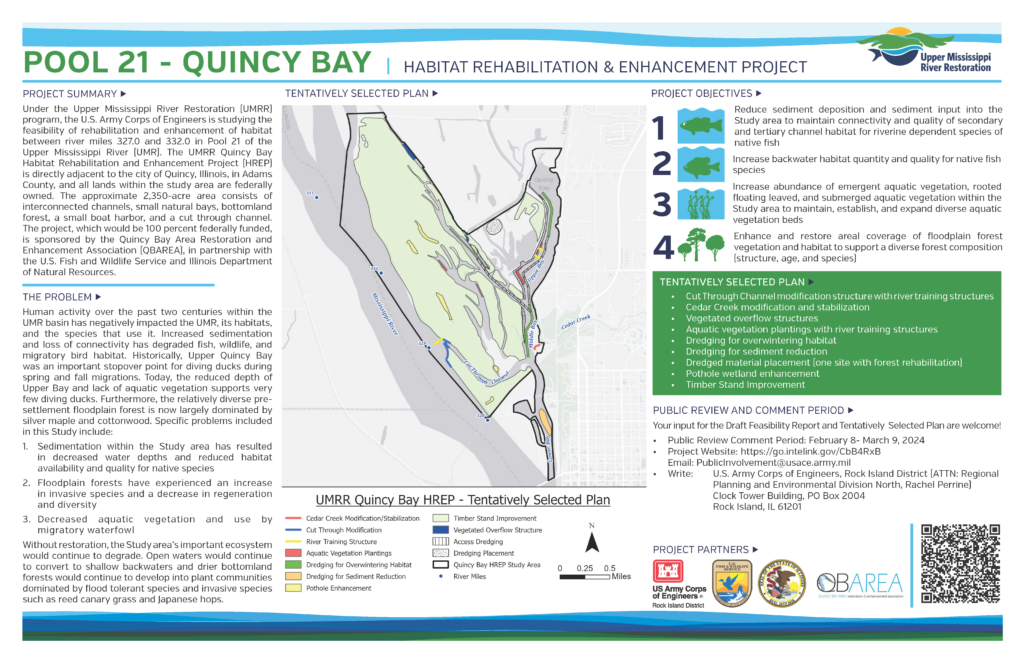‘In my book, this is a great thing’

QUINCY — As the microphone was passed around the crowd of about 350 in the Oakley-Lindsay Center’s Kent Hall Thursday evening, a man wanted to ask Glenn Sanders a question.
Sanders, a retired Illinois Conservation Police district supervisor, is also a member of the Quincy Bay Area Restoration and Enhancement Association (QBAREA), the group spearheading the effort to restore Quincy Bay by dredging it to increase its depth and to build up some of its islands to above flood level to provide stable habitat for wildlife.
“Mr. Sanders, you know this river better than anyone,” the man said. “What do you think of this plan?”
Sanders listed the benefits of the plan and said if someone had told him this would have been possible 20 years ago, he would not have believed them.
“I would’ve told you you were drunk,” Sanders said of U.S. Army Corps of Engineers plan. “In my book, this is a great thing.”
The Quincy Bay Area Habitat Rehabilitation and Enhancement Project (HREP) is located in Pool 21 of the Upper Mississippi River and has a $41 million price tag to revitalize more than 900 acres. While more than $30 million has already been earmarked by the federal government, Thursday night’s open house signaled the finish line for the first phase of planning.
Officials will continue to take public input on the plan through March 9 as the planning phase draws to an end. Design of the plan will take another two years with construction scheduled to begin in 2026 and be completed by 2030.

The Corps describes the Quincy Bay Project as “an 8-square-mile backwater lake complex measuring approximately four miles long with a maximum width of two miles. The study area is composed of interconnected channels, small bays, bottomland forest, a small boat harbor, and a cut through channel. Quincy Bay is one of the largest natural bays in the Upper Mississippi River, providing habitat for a variety of native fish and wildlife species, including resident and migratory birds, multiple species of bats, waterfowl, and many native fish.”
Advocates say the project means more wildlife and visitors to the area, boosting economic development efforts.
Marshall Plumley, Quincy Bay project manager for the Corps of Engineers, said the funding mechanism is close to complete.
“The UMR (Upper Mississippi Restoration) program is funded annually by Congress … this project is one of 23 other projects and up and down the river that are in planning, design and construction,” Plumley said. “So we submit budget requests for all of that work. In addition, we have a long term resource monitoring element of the program that is funded through that annual appropriation as well. So there is not funds all the funds necessary to build this $41 million project right now. As we go through each stage of the process, we request the funds that we need. So for this to get to design and construction, there’s going to be need, there will need to be action from Congress to appropriate those funds for the program.”
U.S. Senator Dick Durbin (D-Illinois) has visited the bay several times and has voiced his support for the project.
Rome Frericks, Quincy Park District executive director and member the QBEARA board, was pleased with the packed house and Plumley said the group’s efforts have been important to get the project this far.
“The agency (QBEARA) has been critical in helping organize public interest and support in the project,” Plumley said. “The project moving into the planning stage and getting on the radar of the larger five state partnership. These teams aren’t just Corps of Engineers. It’s really a team of folks from the Corps, the Department of Natural Resources, the Fish and Wildlife Service and the local interests. So they’ve had a seat at the table through the whole process. And that brings us perspective that’s absolutely vital to the success of the project.”
One important issue for years has been the sedimentation from a cut-through that fills Quincy Bay . Plumley said this should mitigate it and give the bay new life.
“It doesn’t close it (the cut-through) he said. “It modifies how the water moves through that area to deflect a good bit of that sediment away from the project area. It is going to remain open in a way that there’s access into that area, particularly for species that use that deeper water in the channel itself.
“So no, we won’t be closing the channel, but we will be modifying it to address those sedimentation issues.”
Miss Clipping Out Stories to Save for Later?
Click the Purchase Story button below to order a print of this story. We will print it for you on matte photo paper to keep forever.

